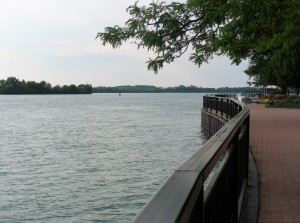Important Bird and Biodiversity Areas Program
The Important Bird and Biodiversity Areas (IBA) Program is a program that works to identify, monitor, and conserve the world’s most important sites for birds and biodiversity. Sites are designated using a science-based approach which sets criteria and thresholds for trigger species. In Canada IBAs are triggered mainly by threatened species, and significant congregations of birds. The exemplary IBA Caretaker Network (started in 2006 in B.C.) took off in Ontario in 2013. Caretakers are volunteers who monitor bird populations, report on threats to IBAs, work with partners on stewardship activities, and help build community awareness about the importance of IBAs.
Lower Detroit River Important Bird and Biodiversity Area
The globally significant Lower Detroit River IBA which extends from the north end of Fighting Island to the mouth at Lake Erie, is important for congregations of birds and waterfowl. Ring-billed Gulls were originally a trigger species (in 1990 there were 34,021 pairs, 3.9% of the North American population on Fighting Island). Recently the gull colony has changed, but Canvasbacks still occur in significant numbers (in 2015, birders counted 9000 along the IBA, 1.7% of its global population)! The IBA is also a winter home to many Redheads and Common Mergansers. Pollution of the river and surrounding wetland areas is the main conservation concern due to the high population along the river (Windsor, Detroit, LaSalle, Amherstberg). Fortunately, organizations such as the Detroit River Canadian Cleanup and the Essex County Field Naturalists’ Club are taking action to protect the area.

The Lower Detroit River IBA at King’s Navy Yard in Amherstberg, ON. Credit: Amanda Bichel
Visit the IBA Canada website to learn more about the IBA Program, Caretaker Network, and how to get involved.
Lower Detroit River IBA Waterbird Count Events
There will be two waterbird count events in the Lower Detroit River IBA this winter on Saturday January 28th and February 25th 2017. The activity will consist of two mornings of identifying waterbirds (mostly ducks) on the river in pre-determined locations. More details will come as we get closer to the date.
Lower Detroit River IBA Waterbird Count Poster
Christmas Bird Count
The ‘
Christmas Bird Count‘ (CBC) is conducted in over 2000 localities across Canada, the United States, Latin America, and the Caribbean.Christmas Bird Counts are conducted on any one day between December 14 and January 5 inclusive. They are carried out within a 24-km diameter circle that stays the same from year to year. These bird observations have been amassed into a huge database that reflects the distribution and numbers of winter birds over time. Birds are indicators of the overall health of our environment. As well as adding an exciting and fun event to the holiday season, the Christmas Bird Count provides valuable insight into the long-term health of bird populations and the environment.
Christmas Bird Counts are generally group efforts, though single-observer counts can and do happen. They are organized at the local level, usually by a birding club or naturalists organization. Volunteers are welcome! For more details about a count, please contact the organizer as listed below:
BL – Rondeau – date TDB (Contact Keith J. Burk: keithburk2@xplornet.com)
NS – Lakeshore – date TBD (Contact eaglecoach@cogeco.ca)
CC – Cedar Creek – December 17th 2016 (Contact Paul Pratt: naturalist@primus.ca)
PP – Point Pelee – date TBD. (Contact Sarah Rupert: tanager@sympatico.ca)
HB Holiday Beach – December 27th 2016 (Contact Jeremy Hatt: hattjeremy@hotmail.com)
SC – Saint Clair – date TBD (Contact Allen Woodliffe awoodliffe@hotmail.com)
Contact Information
To contact the Ontario IBA Coordinator, e-mail: ontarioiba@birdscanada.org
To contact the CBC Coordinator, e-mail: cbc@birdscanada.org

